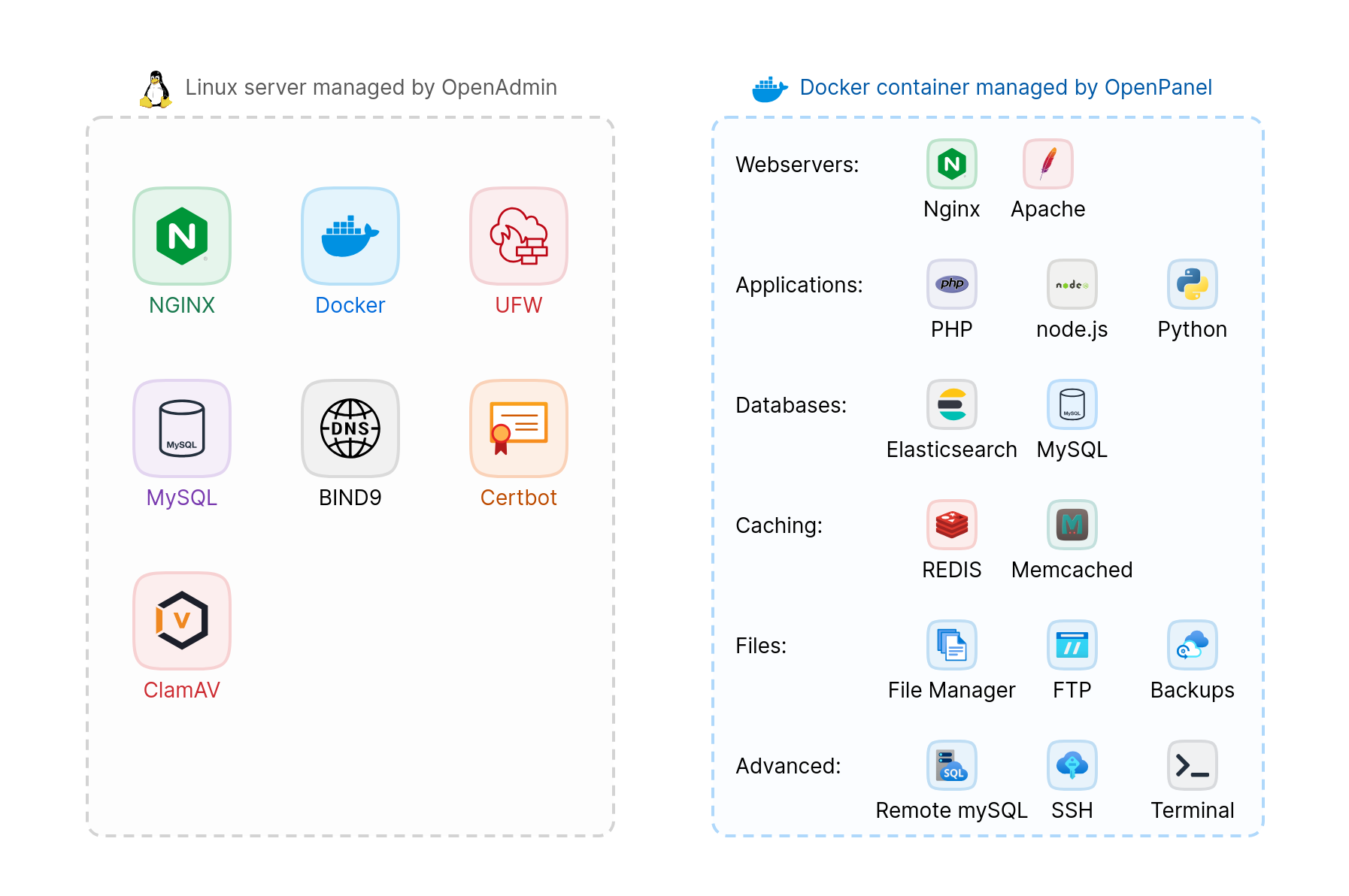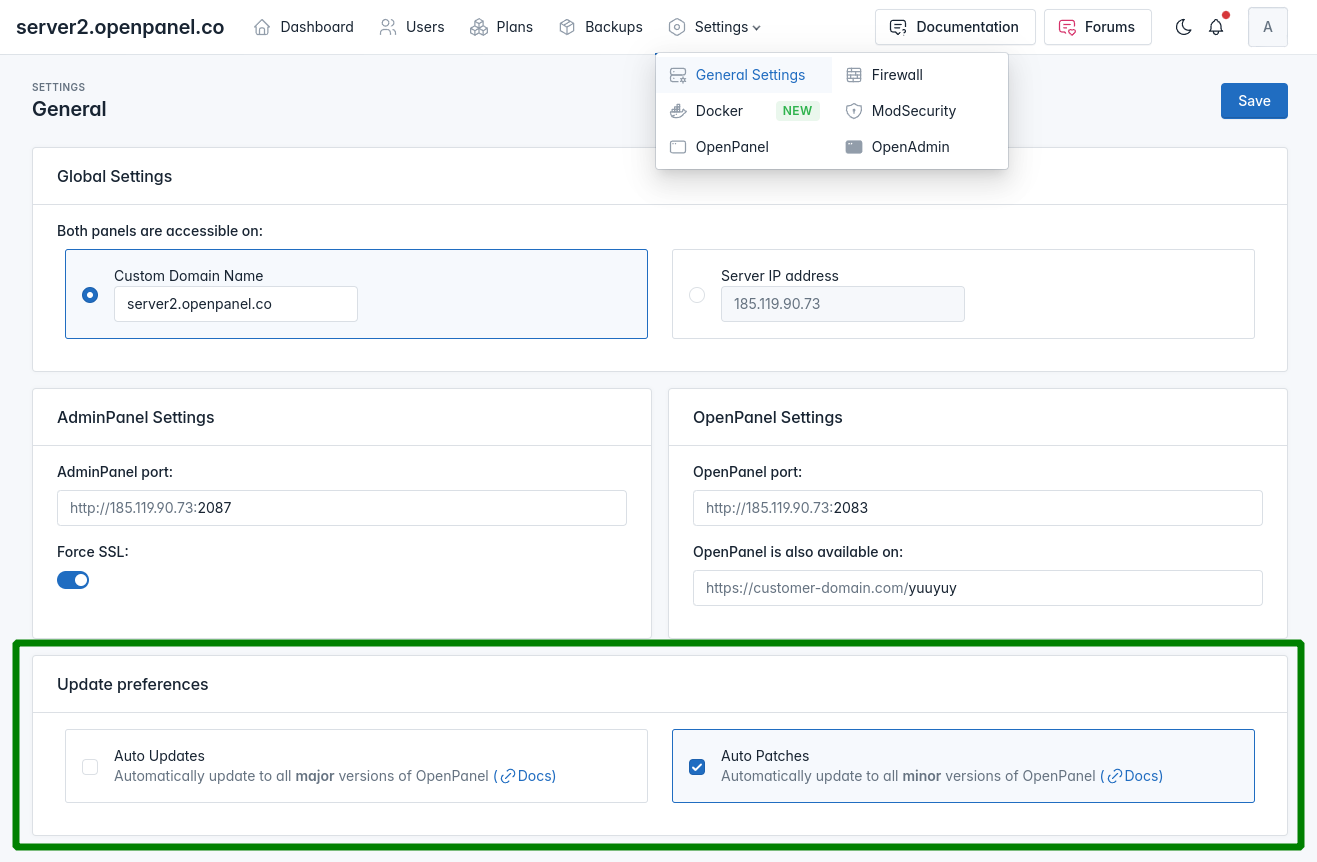Get Started with OpenAdmin
The OpenAdmin offers an administrator-level interface where you can efficiently handle tasks such as creating and managing users, setting up hosting plans, configuring backups, and editing OpenPanel settings.

Requirements
Mimumum Requirements:
- A blank full virtual machine or bare metal server
- Debian 11 / Debian 12 / Ubuntu 22 / Ubuntu 24*(without quotas)
- Minimum of 1GB RAM and 15GB storage
- x86_64/amd64 architecture
If you are using external firewall, the following ports should be opened: 53 80 443 2083 2087 32768:60999
Installation
The installation process takes about 5 minutes. To install openpanel follow these steps:
- Log in to your new server;
- as root via SSH or
- as a user with sudo privileges and type "sudo -i"
- Copy and paste openpanel installation command into the terminal
bash <(curl -sSL https://get.openpanel.co/)
We recommend that you run the installation command within a Linux screen session. The Linux Screen utility allows you to create a shell session that will stay active through a network disruption.
The installation script supports optional flags that can be used to install additional services, skip certain installation steps or display debugging information.
Install on DigitalOcean
OpenPanel is available as a 1-Click app (droplet) on DigitalOcean. Click on the button to spin a droplet with OpenPanel already installed:
or with DigitalOcean api:
curl -X POST -H 'Content-Type: application/json' \
-H 'Authorization: Bearer '$TOKEN'' -d \
'{"name":"choose_a_name","region":"nyc3","size":"s-2vcpu-4gb","image":"openpanel"}' \
"https://api.digitalocean.com/v2/droplets"
Troubleshooting failed installation
In a rare case that the OpenPanel installation process fails you shoud be able to determine the root cause from the error message alone.
You can also run the installation process with the --debug flag and afterwards check the installation log file for errors:
cat /root/openpanel_install.log
In nearly 99.9% of instances, installation failures result from conflicts with residual services from a previous hosting panel or web server. If a web server was previously installed on the server, it is advisable to reinstall the operating system before attempting to install OpenPanel again.
Reporting bugs
If you encountered any errors while running the installation script, and you are able to again reproduce the error on another server (or same after reinstalling the OS) then please copy & paste the installation log file to the community forums.
Post Install Steps
Access OpenAdmin
Run opencli admin command to find the address on which admin panel is accessible. Example output:
root@server:/home# opencli admin
● AdminPanel is running and is available on: https://server.openpanel.co:2087/
To login to admin panel you need a username and password.
Both username and password are random generated on installation.
To view admin accounts:
opencli admin list
To set a new password for the admin account run command: opencli admin password USER_HERE NEW_PASSWORD_HERE
Example:
root@server:/home# opencli admin password stefan ba63vfav7fq36vas
Password for user 'stefan' changed.
===============================================================
● AdminPanel is running and is available on: https://server.openpanel.co:2087/
- username: stefan
- password: ba63vfav7fq36vas
===============================================================
Updates
The panel will check for new updates nightly. If available, it will check your local update and patch preferences and update only when enabled.
- With OpenAdmin
- With OpenCLI
To enable or disable updates, navigate to OpenAdmin > General Settings and check or uncheck the 'Auto Updates' and 'Auto Patches'.

To change update preferences from the terminal use commands:
opencli config update autoupdate yes
opencli config update autopatch yes
If you want to update manually regardless of the schedule, you can run the following command.
opencli update --force
Security
OpenPanel has been built from the ground up with security in mind. Internet history is littered with painful security incidents, so we traded old software compatibility and insecure authentication methods for modern day security measures.
OpenPanel Security features:
- Each user container is isolated by Docker.
- Two-Factor Authentication (2FA) can be activated by users.
- phpMyAdmin and WebTerminal offer auto-login using one-time tokens.
- Users' public services (SSH, MySQL) are accessible via non-standard ports.
- All user actions on the panel are stored in activity log.
- Bruteforce protection and rate limiting are implemented for all panel pages.
- The user panel is segregated from the admin panel and websites.
- All user panel requests are processed in the backend.
OpenAdmin Security features:
- The admin panel can be entirely disabled while retaining all functionality.
- HTTP Basic Authentication can be enabled for the admin panel.
- Admins can change the default port (2083) for the user panel.
- Email alerts and notifications for admin logins from new IP address.
- Bruteforce protection is enforced for the admin panel.
- Passwords are stored as salted SHA512 hashes by default (5000 rounds).
- The admin panel is isolated from the user panel and websites.
- Separated database software for admin and user accounts.
Websites:
- ModSecurity Web Application Firewall (WAF) can be activated for domains, with the OWASP core ruleset.
- IP blocking per domain name.
- Hotlink protection per domain using vhost files.
- No outgoing emails, only SMTP!
- TLS (Transport Layer Security) is utilized.